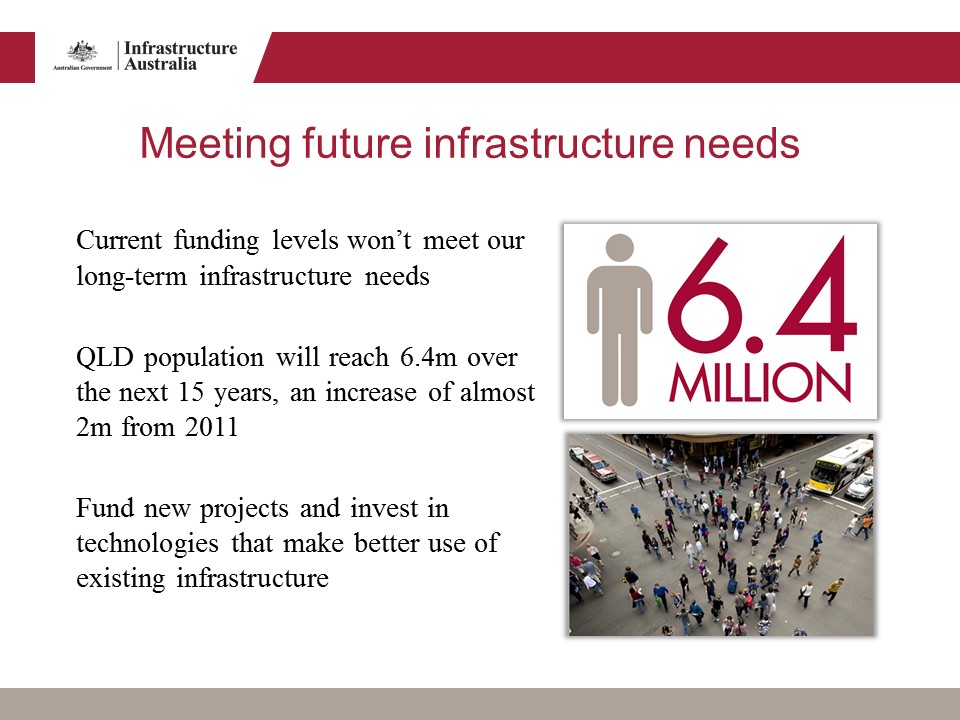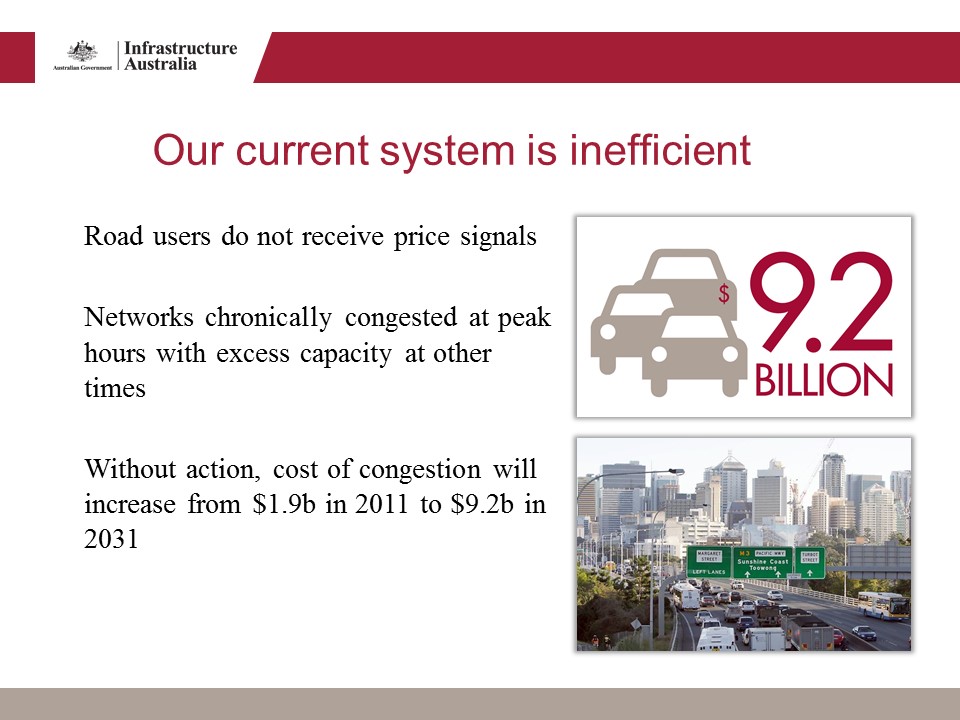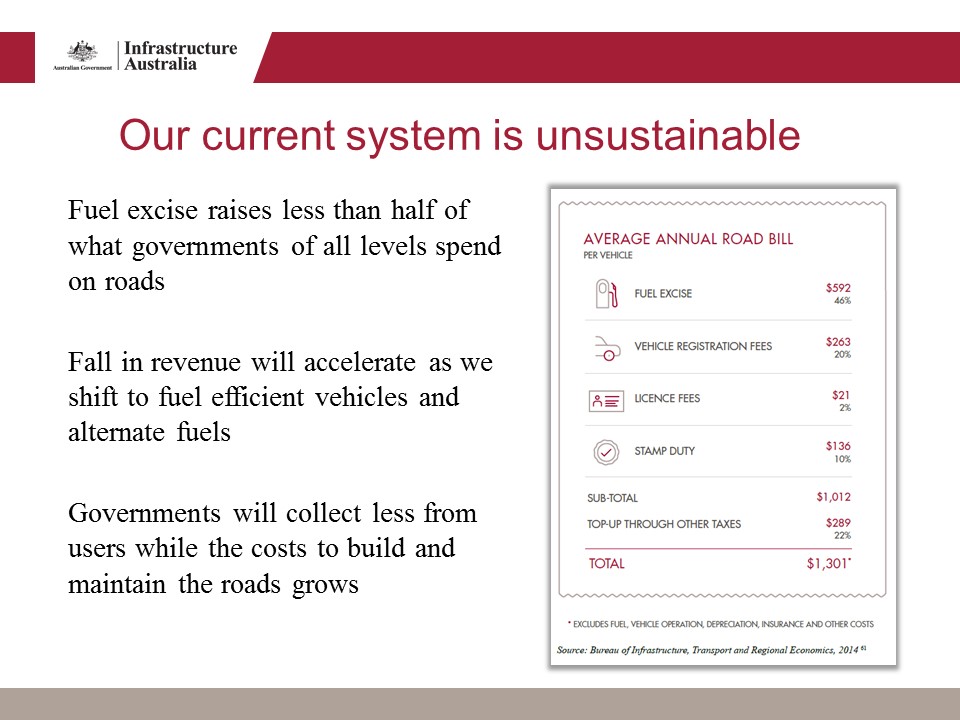
Introduction
Good morning ladies and gentlemen. It is a great pleasure to be here in Brisbane this morning for the 2016 Queensland Infrastructure Summit.
Thank you to the Infrastructure Association of Queensland for the kind invitation, and to Steve for his excellent presentation setting out the context for a user-pays approach to road funding.
It is very timely to be here this morning to talk about the case for road-user charging and how we can build consensus in the community around this important opportunity for reform.
Last week Transurban released the first tranche of a new study which shows that Australians are open to trying a fairer and more transparent way of paying for their road use.
The study found that the more participants experienced a direct and transparent way of paying for their road use, the more engaged and open they were to shifting to a user-pays system.
Transurban has made an important contribution to the evidence base for road-user charging with this study, and it supports the case for a sophisticated public debate on road reform.
As the nation's independent infrastructure advisor, Infrastructure Australia has been particularly heartened to see mature cross-party leadership at the Federal level on this issue.
There is no doubt that a pragmatic approach to reform is needed to elevate this issue beyond day to day politics and pursue Australia's best interest.
With that in mind, this morning I want to offer Infrastructure Australia's perspective on road reform, and why we believe it is time to move towards a fairer and more sustainable system of funding our roads.
I will begin by talking briefly about the three landmark reports we have delivered in the past 18-months, before outlining why the current system of paying for our roads is unfair, inefficient and unsustainable.
I will talk about why community engagement is absolutely key and why a public inquiry, led by Infrastructure Australia, is needed to chart a pathway towards a sustainable system of funding our road networks now and into the future.

Audit, Plan and IPL
For those who are not familiar with what we do, Infrastructure Australia provides rigorous, independent advice to governments and the community on the infrastructure projects and reforms Australia needs over the next 15 years.
Over the past 18 months we have been busy delivering three major reports:
The Australian Infrastructure Audit—a comprehensive review of the current state of Australia's infrastructure and our future needs across transport, water, energy and telecommunications. The Audit provides Infrastructure Australia and Australian governments with a critical evidence base for where investment and reform is required.
The Australian Infrastructure Plan—Launched in Brisbane with the Prime Minister back in February, this is a reform based document, which provides a road map for governments, business and the community to address Australia's infrastructure challenges—and
The Infrastructure Priority List—which sits alongside the Plan and provides a prioritised list of nationally-significant investments and guidance to decision makers on where they should direct funding.

Infrastructure Priority List
The Infrastructure Priority List is one of the most important aspects of our role as the nation's independent infrastructure advisor.
We are currently assessing a record number of business cases as Australian governments and industry embrace the need to better align project proposals with an identified infrastructure need.
In fact, the Infrastructure Australia Board has assessed 16 business cases in total since February.
Just last week, we added two Queensland projects to the List: the Caloundra Road to Sunshine Motorway section of the Bruce Highway Upgrade and the M1 Pacific Motorway-Gateway Motorway Merge Upgrade.
Our strong relationship with organisations like Building Queensland is supporting a significant improvement in the standard of business cases we are seeing for major projects, which helps to drive better outcomes for infrastructure users around the country.
With a strong pipeline of business cases continuing to be assessed into 2016–17, the Infrastructure Priority List has clearly become a platform for better infrastructure decision-making,

Meeting future infrastructure needs
While a credible pipeline of infrastructure projects is essential for long-term infrastructure planning, so too is finding a sustainable way to fund these projects.
One of the central themes underpinning all our work to date is that Australia needs a material increase in funding for public infrastructure.
With a growing population, current levels of public sector expenditure in Australia will be insufficient to meet our long-term infrastructure needs.
Here in Queensland, the state's population will grow significantly to reach 6.4 million over the next 15 years, an increase of almost 2 million people from 2011.
To harness this population growth, Queensland, and the other States and Territories across Australia, will need a material increase in funding for public infrastructure.
Critically, we are not just talking here about funding new projects, but also the costs to maintain and operate existing infrastructure.
A key recommendation in our 15-year Infrastructure Plan is that Governments should increase funding for investments in projects and technologies that make better use of existing infrastructure.
In practice, this means embracing technologies that drive greater efficiency across transport assets and networks.
On urban roads, Intelligent Transport Systems are already collecting, storing and analysing data on traffic counts, travel times, congestion, incidents and faults through sensors at intersections to enable better management of traffic flows.
For example, on a section of the Monash Freeway in Melbourne, the installation of electronic signs to improve traffic flow and additional CCTV cameras has helped increase capacity in each lane by close to 20 per cent.
Investment to make better use of existing infrastructure is just as important as funding new projects.
But in the face of increasing budget pressures to fund welfare and health services, taxpayer funds alone will be insufficient to meet our future infrastructure needs.
This is why diversifying the pool of funding available for public infrastructure investment must be a major priority.
One of the major opportunities to do this, as identified in our Plan, is changing our approach to how we pay for roads.
Currently the taxpayer is directly involved in funding road infrastructure across its planning, delivery and operation.
This approach is problematic as it means that infrastructure funding, including for roads, is at the mercy of the annual budget cycles of governments, and exposed to a variable policy landscape.
That's why one of the key recommendations in the Plan is that we need to structure our infrastructure markets so they strike the right balance of taxpayer and user funding and drive improvements in service delivery.

Our current system is unfair
Around the world, experience shows that infrastructure is best delivered under a user-pays structure in a well-functioning, well-regulated market.
The direct link between usage and supply delivers services that are efficient, responsive to consumer demands and financially-sustainable.
These market structures provide price signals to users that reflect the cost of supply, and communicate the demand profile back to infrastructure providers.
Under our current system for funding roads, the link between usage and charging is weak.
What we pay is only loosely related to what we use and how our use of vehicles impacts other users.
Each and every taxpayer carries the burden of building and maintaining our roads.
This means a person who doesn't drive or own a car is effectively subsidising people who do.
Meanwhile, it costs the same to travel on the Gateway or Pacific Motorway as it does on the Birdsville Track.

Our current system is inefficient
Another weakness in the current system is that road users do not receive price signals to minimise their impact on other users and the broader network.
The result is a network which is chronically congested for portions of the day, but with excess capacity across most of the 24-hour cycle.
With Queensland's population set to increase significantly in the next 15 years, the economic impact of road congestion warrants attention.
The Australian Infrastructure Audit showed that without action, the cost of congestion across Brisbane, the Gold Coast and the Sunshine Coast will increase from $1.9 billion in 2011 to $9.2 billion in 2031.

Our current system is unsustainable
In addition to being unfair and inefficient, our current system of paying for our roads is simply unsustainable.
As everyone in this room would well know, Australians currently pay to use the road network through a combination of fuel excise paid at the pump, vehicle registration, stamp duty and other charges.
On average, motorists pay over $1,300 a year in road related taxes. And that's before the cost of fuel, maintenance, insurance and tolls are included.
Since its introduction over 100 years ago, fuel excise has been an effective way of paying for roads. But this is no longer the case.
Today, fuel excise raises less than half of what Australian governments of all levels spend on roads.
This fall in revenue will accelerate over coming decades as we shift towards more fuel efficient vehicles and alternate fuels.
This means we will be collecting less from users while the costs to build and maintain the roads continue to grow.

A fairer user pays approach
A new framework for road user charging can address all of these problems
Under a fairer user pays system, fuel excise and registration fees would be replaced by road users only paying for the kilometres they travel on the roads they use.
Unlike the current approach where taxes and charges are allocated to various government spending priorities—both in transport and other areas, this revenue would be reinvested back into the transpor network.
A fairer user pays approach would also allow charging to be linked to funding and supply to be linked to demand.
This means secure, sustainable funding for roads—and better services for users.
The imperative for change is clear, but most importantly—we need to bring the community on the journey with us.

Building community consensus
Changing how we pay for roads will not be easy. The existing structures are familiar and the reforms are complex, but the rewards are substantial.
Some motorists may be concerned about what these changes will mean for them.
This is understandable, and it's why an open discussion about these proposals is as important as the reform itself.
Importantly, Transurban's road usage study shows that the community is ready to rethink how we pay for infrastructure services and how we deliver road networks to meet the needs of a diverse and growing economy.
It shows that road user charging can work, and that Australians are open to trying a fairer and more transparent way of paying for their road use.

Public inquiry into road reform
To progress road reform, we need a detailed, calm conversation and we need it take place outside of day-to-day politics.
Infrastructure Australia has recommended that the Australian Government initiates a public inquiry into the existing funding framework for roads and the development of a fairer road user charging reform pathway.
The inquiry should be led by an independent body like Infrastructure Australia, and supported by large-scale voluntary trials of road user charging options.
The public inquiry should consider:
Flaws in the existing charging framework—including fairness, financial sustainability and economic efficiency;
The optimal approach for road user charging and transport infrastructure funding in Australia;
The social implications of charging reform, including transitional and distributional impacts of replacing current taxation with direct user charges; and
A detailed reform pathway for transition to a full user pays model for roads.
Conclusion
We firmly believe that Australia needs a public inquiry to chart a pathway to a fairer and more sustainable approach to funding our roads.
Once the community understands the limitations of the current system, we can then begin to think about how a user pays system of road funding would work in practice.
The pathway to reform is likely to stretch over the next decade, but it must start now if we are to deliver improvements in network performance, address fairness issues and provide a sustainable source of funding for roads.
Thank you